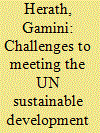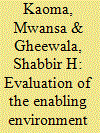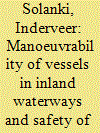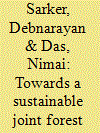|
|
|
Sort Order |
|
|
|
Items / Page
|
|
|
|
|
|
|
| Srl | Item |
| 1 |
ID:
160458


|
|
|
|
|
| Summary/Abstract |
In 2015, the UN proposed the Sustainable Development Goals; they were accepted by 193 countries. Sri Lanka faces many challenges in implementing the SDGs. The lack of reliable and recent data is a serious issue. Another issue is the weak institutional capacity of Sri Lanka, which has led to poor governance and policy incoherence. There is no strong political will, and interministerial conflicts are rampant. Unless these issues are properly addressed, the yahapalanaya (good governance) government of President Sirisena may not contribute well to achieve the SDGs by 2030.
|
|
|
|
|
|
|
|
|
|
|
|
|
|
|
|
| 2 |
ID:
180102


|
|
|
|
|
| Summary/Abstract |
The low adoption rates of modern bioenergy systems in the rural areas of Zambia indicate shortcomings within the existing institutional arrangements for a conducive enabling environment for their deployment. To address them, this study employed the SWOT–AHP (Strengths, Weaknesses, Opportunities, Threats-Analytic Hierarchy Process)-TOWS (Threats, Opportunities, Weaknesses, Strengths) technique to assess the effectiveness of such arrangements by building on the insight of the identified stakeholders. This led to the generation of ideas for further policy development for rural-based bioenergy systems. The SWOT-AHP analysis shows that the negative aspects (weaknesses and threats) associated with the enabling environment for the promotion of rural-based bioenergy systems dominate their positive counterparts (strengths and opportunities). Among others, the following policy considerations are vital to the enhancement of the enabling environment in this context: (1) building relevant policy actors' analytical capacity in biomass supply chains for cooking and heating fuels, (2) seeking developed-country support for the effective transfer of bioelectricity technologies, and (3) developing a framework used in planning for the sustainability of rural-based bioenergy systems. To increase the likelihood of their adoption, these strategies must be aligned with the country's higher-level national development goals.
|
|
|
|
|
|
|
|
|
|
|
|
|
|
|
|
| 3 |
ID:
099618


|
|
|
|
|
| Publication |
2010.
|
| Summary/Abstract |
This article briefly outlines the food-water-energy interlinkages for sustainable development in India. It begins by underlining the emerging severe land constraint and relates it to water development strategies since water use not only raises agricultural productivity, but releases the land barrier by intensity of land use. Given this problem, energy becomes a related focus and of course, is by itself another major issue in sustainable development and long-term security. The article begins with estimates to show that India is probably urbanising faster than generally thought and together with a severe water development crisis, is in a difficult situation. It also develops the profile that a similar situation exists in the energy sector. In each problématique, the article ends with some governance issues and suggestions.
|
|
|
|
|
|
|
|
|
|
|
|
|
|
|
|
| 4 |
ID:
187143


|
|
|
|
|
| Summary/Abstract |
A green and sustainable mode of transport, the inland waterway transport in India will see accelerated growth with the new Inland Vessels Act, 2021. This increased traffic growth in restricted waters will lead to economic, environmental, and safety challenges. Good manoeuvrability of inland vessels is critical to resolve these concerns. The world over, inefficient manoeuvring has resulted in several incidents which have affected the safety of navigation and maritime trade. Manoeuvrability of seagoing vessels must meet the minimum standards as per International Maritime Organization (IMO) Resolution MSC.137(76) and the MEPC1/Circ850/Rev.3 guidelines. In comparison, only a few countries, river commissions, and classification societies have specified criteria for navigation tests for inland vessels, and this does not include India. Manoeuvrability criteria and results of the tests are essential to facilitate the safe movement of vessels. This article discusses the results of full-scale manoeuvrability tests of inland vessels conducted by the author on India's national waterways and the Indo-Bangladesh Protocol route. It proposes manoeuvrability criteria for inland vessels plying in the inland waterways of India, including cross-regional protocol routes. The article also recommends measures to improve the safety of navigation in inland waters.
|
|
|
|
|
|
|
|
|
|
|
|
|
|
|
|
| 5 |
ID:
125460


|
|
|
|
|
| Publication |
2013.
|
| Summary/Abstract |
The purpose of this paper is to explore to what extent the integrated infrastructural system in Hammarby Sjöstad, Stockholm, also named the Hammarby Model, reduces the metabolic flows of the district, and to what extent the district is self-sufficient, in terms of generated energy. Furthermore, the paper aspires to help create a deeper understanding of the system in order to guide the implementation of similar models in other districts, creating more sustainable cities. The method has been to quantify the local mass and energy flows of the model, using the secondary energy generated within Hammarby Sjöstad as basis when creating the system boundaries of the calculations. The findings demonstrate that the Hammarby Model reduces the metabolic flows of Hammarby Sjöstad but that the district is far from self-sufficient in terms of secondary energy. The conclusions of the paper are that the development of integrated infrastructural systems is one way to help create more sustainable cities. However, in order to reduce metabolic flows even further, the efficiency of the system must be improved by integrating more renewable energy sources. At the same time less energy has to be used in the households.
|
|
|
|
|
|
|
|
|
|
|
|
|
|
|
|
| 6 |
ID:
117681


|
|
|
|
|
| Publication |
2012.
|
| Summary/Abstract |
Poverty remains a continuing crisis in Southeast Asia, regardless of the timing and severity of the global economic crisis. Moreover, being poor and falling into poverty is often beyond an individual's capacity to avoid. Who should help these individuals and how much help should be given - the individuals themselves, their families, their friends, their communities, and/or their governments? A just and financially sustainable social protection system is perhaps an answer to those questions. This paper provides an analytical background for the five articles in this special issue of ASEAN Economic Bulletin, dealing with issues on social protection in Indonesia, Malaysia, Singapore, Thailand, and Vietnam. It discusses what social protection is, reviews an analytical framework of a continuum pioneered by Esping-Anderson (1990), and attempts to locate where the five Southeast Asian countries are in the continuum.
|
|
|
|
|
|
|
|
|
|
|
|
|
|
|
|
| 7 |
ID:
082039


|
|
|
|
|
| Publication |
2008.
|
| Summary/Abstract |
More than eighty years since Chief Deskaheh petitioned the
League of Nations for Haudenosaunee self-determination, it is
becoming clearer that the existing rights discourse can take indigenous
peoples only so far. States and global/regional forums
have framed self-determination rights that deemphasize the responsibilities
and relationships that indigenous peoples have
with their families and the natural world (homelands, plant life,
animal life, etc.) that are critical for the health and well-being of
future generations. What is needed is a more holistic and dynamic
approach to regenerating indigenous nations, and I propose
the concept of sustainable self-determination as a benchmark
for future indigenous political mobilization. Utilizing case studies
of indigenous community regeneration such as the Native
Federation of Madre de Dios (FENAMAD) in Peru and the
White Earth Land Recovery Project (WELRP) on Turtle Island
as well as analyzing the existing research on rights, political
mobilization, and ecosystems, this article identifies alternatives
to the existing rights discourse that can facilitate a meaningful
and sustainable self-determination process for indigenous peoples
around the world. Overall, findings from this research
offer theoretical and applied understandings for regenerating
indigenous nationhood and restoring sustainable relationships
on indigenous homelands
|
|
|
|
|
|
|
|
|
|
|
|
|
|
|
|
| 8 |
ID:
076321


|
|
|
|
|
| Publication |
2006.
|
| Summary/Abstract |
This article demonstrates that the resistance movement of forest communities in western Midnapore division in West Bengal, which acted as a key precursor to the joint forest management (JFM) programmes in India through a June 1990 Ministry of Environment and Forests circular, was based to a large extent on the successful experience of JFM in Arabari Hills under this division. In this particular locality, the resistance movement of forest communities had been mobilized for a long time by poor forest communities fighting for their community rights to forest resources as a matter of immediate survival, opposing top-down approaches to forest management. A detailed study of the existing four Forest Protection Committees (FPCs) of this area confirms that these immediate survival needs, generating mainly sustenance and income from non-timber forest products (NTFPs) for FPC members, are the key element for the long-term sustainability of a JFM system.
|
|
|
|
|
|
|
|
|
|
|
|
|
|
|
|
| 9 |
ID:
169135


|
|
|
|
|
| Summary/Abstract |
Rapid population growth in Pacific island cities far exceeds employment opportunities and is contributing to rising urban inequality and social exclusions. Livelihoods in the informal urban sector, such as market vending, provide much needed income, rural–urban connectivity and food security, but remain largely excluded from policy and planning frameworks. Spatial, economic and social exclusions limit vendors’ economic advancement, their influence over decision‐making, and their access to basic services. Local communities close to informal markets fill some of the gaps left by the policy neglect, but investment and strategic management remains inadequate when vendors do not have secure market places and recognised rights to work. This article reports on a study of three informal markets in Honiara, Solomon Islands. These markets lack legal status but make significant contributions to urban development and economic opportunities. Drawing on surveys and focus groups with vendors and urban decision‐makers we explore the impact of informal markets on urban economies, how social and institutional relationships hinder vendors’ economic advancement, and the opportunities to create more inclusive livelihoods that could contribute to equitable cities.
|
|
|
|
|
|
|
|
|
|
|
|
|
|
|
|
|
|
|
|
|